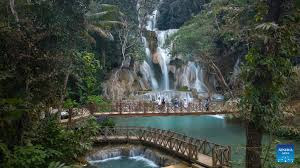A Natural Wonder and Tranquil Escape
Nestled in the lush jungles of northern Laos, Kuang Si Falls is a breathtaking natural wonder, captivating visitors with its cascading turquoise waters and serene surroundings. Located about 29 kilometers (18 miles) south of the UNESCO World Heritage city of Luang Prabang, Kuang Si Falls is one of Laos' most visited and iconic landmarks. A journey to the falls offers a refreshing escape into nature, blending adventure, beauty, and relaxation.
The Majestic Beauty of Kuang Si Falls
Kuang Si Falls, also known as Tat Kuang Si, is a three-tier waterfall that plunges from a height of about 50 meters (164 feet) into a series of dazzling pools below. The waterfall is famous for its crystal-clear waters, which take on a stunning turquoise hue due to the high mineral content in the limestone rock. As the water cascades down the rock formations, it forms a series of smaller, terraced pools that invite visitors to take a dip and cool off from the tropical heat.
The sound of rushing water, the cool mist in the air, and the vibrant greenery surrounding the falls create an enchanting atmosphere. Whether standing at the foot of the falls or hiking to the top, visitors are treated to panoramic views of the jungle and the vibrant blue pools below.
Exploring the Area
A visit to Kuang Si Falls is more than just admiring its beauty; it's an adventure waiting to be explored. The surrounding area offers several hiking trails, leading to viewpoints where you can see the falls from different perspectives. The most popular hike is a short but steep trail that takes you to the top of the falls, where you can peer over the edge and see the source of the cascading water.
For those who prefer a more relaxing experience, the lower pools are perfect for swimming. The water is cool and refreshing, offering a serene respite from the tropical heat. Some of the pools are shallow, making them family-friendly, while others are deeper and ideal for diving. Just be mindful of the slippery rocks.
One of the standout features of Kuang Si Falls is the peacefulness of the area. Although it can get crowded during peak tourist seasons, the falls are often a place of quiet reflection, with plenty of hidden corners where visitors can find solitude and connect with nature.
The Bear Rescue Center
Another unique aspect of Kuang Si Falls is the Tat Kuang Si Bear Rescue Center, located at the entrance to the falls. The center is a sanctuary for Asiatic black bears, also known as moon bears, that have been rescued from poachers and illegal wildlife trade. The bears are cared for in a protected environment, and visitors can learn about the efforts to conserve these endangered animals.
The rescue center offers a meaningful addition to the visit, allowing tourists to witness Laos' commitment to wildlife preservation and the rehabilitation of bears that would otherwise face an uncertain future.
How to Get There
Kuang Si Falls is easily accessible from Luang Prabang, and most visitors opt to visit as part of a half-day or full-day trip. The journey can be made by tuk-tuk, minivan, or motorbike, with scenic views of rural Lao villages, rice paddies, and forests along the way. Alternatively, adventurous travelers can rent bicycles and enjoy a more immersive journey through the Lao countryside.
The entrance fee to the falls is modest, and the funds help with maintenance and conservation efforts in the area. There are also picnic areas, small restaurants, and changing facilities near the entrance, making it a convenient and enjoyable experience for all.
Tips for Visiting Kuang Si Falls
Best Time to Visit
The ideal time to visit Kuang Si Falls is during the dry season, from November to April, when the water is clear and the weather is more pleasant. However, the falls are more powerful during the wet season (May to October), offering a more dramatic sight, but with muddier trails and cooler swimming conditions.
Clothing
Comfortable hiking shoes are recommended for those planning to explore the trails, as the paths can be slippery, especially during the rainy season. Bring a swimsuit and a towel if you intend to swim.
Go Early
To avoid crowds, it's best to visit in the early morning or late afternoon, especially if you want to experience the tranquility of the falls.
Conclusion
Kuang Si Falls is more than just a beautiful waterfall; it's a place where nature, wildlife, and culture intertwine, offering visitors an unforgettable experience. Whether you're hiking through the jungle, swimming in the turquoise pools, or learning about the moon bears, Kuang Si Falls is a must-see destination that showcases the raw beauty of Laos.



Comments
Post a Comment